It's long but here goes (missing my sweet tables and some other neat pictures):
First impressions:
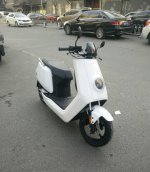
For the purposes of this review I tested out the more expensive RMB 4999 (USD 770)
Power Version of the Niu N1 for about 2 weeks place it in direct comparison
to the scooter I already own.
I will not be comparing this e-scooter to e-scooters that are available
outside of China, I will instead be comparing this scooter to the
high end China-made e-scooter I already own: my two year old 72v 2000w
Da Gui Wang (King Turtle), a Honda Joker clone.
At first glance the Niu N1 has a slick exterior, with novel features
like an original appealing design, a unique LCD display and LED lights.
On closer inspection however, the scooter is largely built around
componentry commonly available among Chinese e-scooters.
If you take a look at the handlebars they have a very similar
layout to what can be seen on a standard Chinese style
e-scooter: a fairly muted horn more fit for a bicycle, headlight
and indicator buttons seemingly identical to those of other scooters,
side view mirrors appearing of similar construction and style.
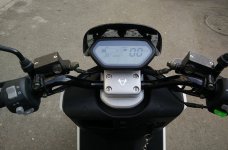
Admittedly this was initially of some concern, but after tooling
around with the scooter I have discovered that, though components
appear to be quite similar it’s in details that matter.
Yes, the scooter implements components already
widely available, but they are built properly. The side view
mirrors appear to stay fixed and useable. They do not swing
around like those on my King Turtle.
The LCD is more user-friendly for first time riders, indicating
directly the battery capacity left in percentage terms – warning
users when running out – and indicating useful things like
current draw, and economy mode for optimal mileage.
In comparison My King Turtle display on the other hand largely relies
on voltage to relay power consumption. At peak charge the voltage
readout will at about 80 resting volts. When it comes time to
charge it should be at lowest about 72 volts. This is hardly
practical for first time users and is not really that reliable
a measure of consumption.
Additionally the scooter includes handy things like a usb charger
in the front, a little spot for random things like water battles
and mobile phones beneath the dash and a vehicle seeking
button on the transponder, which makes the scooter light
up and beep when you can’t remember exactly where you left it.
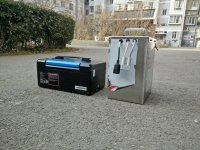
As for the ride itself, smooth acceleration, reliable and accurate
stopping, a little stiff as far as suspensions goes, but overall,
none too different from what I am used to.
Some have claimed the scooter is a little on the heavier side,
to this i say: on average its about as heavy as any other
scooter of equivalent size and specification, easily pushed
especially without the battery and much lighter than a gas scooter.
Battery:
Although Niu’s advertised mileage of 100kms is misleading,
the battery that powers the Niu is among the best available.
The advertised 100km range touted by the advertisements is
based on the assumption that a rider will be riding at 20km/h,
the legal speed limit for e-scooters in China.
In practice, despite the rules, nobody rides an e-scooter this
slowly and when you’re moving at speeds of 30-40km/h
you can reasonably expect the scooter to last you about 50km.
Yes, this is a substantial difference when compared with
the advertised range, but it is consistent with other lithium
batteries on the market and I feel that given the battery
is so convenient to remove, this is easily made up for by
the fact that it will last you 3 years and can be charged
anywhere you go – much like a mobile phone.
The Niu battery is slotted conveniently in a purpose built
compartment for the scooter beneath your feet, it has
a rugged computer style power connector, it does not
shake around and does not occupy the storage space
underneath your seat.

By designing the battery to be carryable and making
it light at 10.5kg, the battery is easily carried by all
and can be removed and charged in all manner of
locations from offices to homes and anywhere with a port.
With an average e-scooter, due to the weight and
size of the traditional lead acid battery powering
the machine, you’re basically expected to leave
your battery contained in the scooter.
This poses a problem for a great majority of Chinese
people chiefly for two reasons: Chinese people
commonly live in apartment buildings without ground
level charging facilities, and e-scooter batteries are
easily stolen from scooters.
My current e-scooter battery is tall, less comfortable to
handle and largely occupies much of the compartment space
beneath my seat. Perhaps the greatest annoyance about
lithium battery setups for typical scooters are that they
are not really purpose designed for the area they occupy.
My battery moves a bit within the chamber and its
connections are susceptible to fraying at the point of
connection.
Rideability features:
Power cuts
The Niu scooter alarm is deactivated when the
battery is removed, which kind of makes it
pointless, also the alarm could do with being a
little louder.
Another personal feature or annoyance, depending
how you choose to interpret it, is that when you
reach 15% battery capacity, the scooter cuts your
speed down to 20km/h to get the most mileage
out of the battery.
In comparison when my King Turtle gets down to
about 70 volts you’re never really entirely sure
when the scooters going to run out of juice –
when it does it’s sudden and you’ll be stranded for
the worse.

This I think is actually a very noob friendly
feature for the scooter which ensures, despite the
annoyingly slow speed, that users will hopefully
not get stranded miles away from home and without
a hope.
Gears
For those experienced scooter riders this is again
arguably unnecessary but I think it will help with
adjusting newer riders to the road. The N1 features
three ‘gears’, the first capped at 20km/h and the
last at the scooter’s full speed of 45km/h. This feature
assures that new riders – especially children and
the elderly – will not overreach on their first expeditions
and get themselves into trouble.
Smart features
Perhaps the most instantly useful smart feature
included with the N1 is the GPS tracking feature.
The N1 can provide location updates even with the
battery detached. I suspect this is likely due to some
kind of reserve battery hidden somewhere in the
chassis or the GPS chip.
Other features included with the N1 include the ability
to provide remote diagnostics. A basic multi-category
summary of your scooter’s health. Mine reports all is well,
and I haven’t encountered any problems with the
scooter as yet, to know how accurate the diagnostics are.
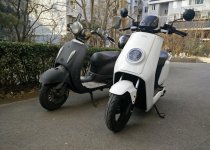 Performance
Performance
The difference in performance is noticeable between
my scooter and the Niu. The Niu tops out at a maximum
flat speed of about 45km/h, my scooter can go up to
about 65km/h. The Acceleration between the two is
again in my favour but only marginally so.
To qualify the above statement my scooter runs on
72v with the Niu fixed at 60v. If a Niu were to run
a similar specification, the performance would
likely be similar but the battery weight and size
would likely go up making it less convenient to haul
around.
I will add here that with the factory controller my
scooter was supplied with, acceleration was
unreasonably quick making the scooter bolt with
the slightest touch of the throttle, making for an
uncomfortable and unsafe experience – an annoyance
that would largely deter some users.
Notes on appearance/bodywork
Though my scooter has been going fairly solid for 2 years
I will say its appearance has taken a bit of a beating.
I’ve banged it a few times through general stupidity
and there are now bits of frame missing from the chassis.
My scooter is mostly easily breakable plastic and
sparse metal wrapped around a fairly solid metal skeleton.
The Niu appears at touch to be sealed better
with what may be a higher quality plastic. In
addition things like the handlebars are properly
fixed together with the side mirrors and lights,
instead of being held together by plastic cable
ties as seen on my own bike. Time will tell as
for its true durability but it does appear to be a
little more solid.
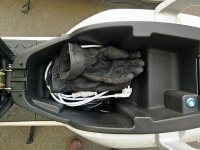 Conclusion:
Conclusion:
The main points of criticism for this scooter are fairly minor.
If I were to buy a scooter again, or if i were to
recommend a good starting scooter, I would most
certainly recommend the Niu over other models. The scooter
is simply made better.
Construction on the Niu is more solid, the scooter is capped
at a reasonable speed of 45km/h - which will make it
friendlier for first time riders - the lithiums are light and will
last several years, and at 5000yuan it is a very reasonably
priced proposition compared with scooters of a similar category.
Comparing the scooter like for like, the Niu is awesome.
The only thing I think that may deter some prospective
buyers from purchasing a Niu over another scooter is
the speed/acceleration offered in comparison to the competition.
I hope that Niu does make a larger capacity scooter in the future
that would be something that would definitely seal the deal for me.








